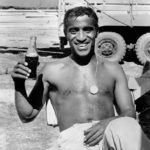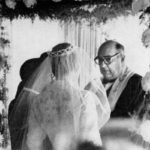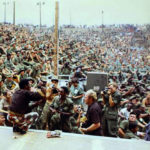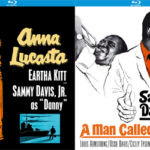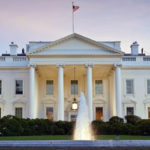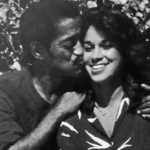Civil Rights: JFK, MLK and Nixon
In many ways, the story of Sammy Davis, Jr. is the story of race consciousness in America: a complicated and unsatisfying mix of oppression, hatred, struggle, judgement, and triumph. Throughout his career, and subsequently in retrospect, Davis has been endlessly criticised by armchair psychoanalysts – firstly for wanting to be white, and then for wanting to be black (his ‘soul brother’ transformation in the late 1960s and early 1970s often being dismissed as just another impression from a gifted mimic).
An oft-quoted, possibly apocryphal, line of Davis’s from the 1970s is “You know, I’ve worked all my life to be white, and now black is beautiful.” A full and fair assessment places Sammy in Jim Crow America for most of his life, sees him fighting bigotry for much of his career, and holds that the same instincts of activism saw him embrace both Rev. Dr. Martin Luther King, Jr. and President Richard Nixon.
Early experiences of racism
Sammy’s experiences following his drafting into the Army in 1944 were pivotal for his understanding of race relations in America. Previously he had been shielded to a large extent by his father from the realities of black experience. But at Fort Warren, Cheyenne in Wyoming, during basic training, he was subjected to the full brunt of threatened white privilege. In March 1943, the War Department had racially integrated all recreation and transportation facilities on stateside bases and the impact on black soldiers was immediate. Sammy suffered beatings and racial abuse, and was doubtless not alone. When he joined a Special Services unit to perform for troops, however, he discovered that his sheer talent could win over even deeply prejudiced white audiences. “My talent was the weapon … the way for me to fight.”
Emerging from the army with a new and devastating awareness of race relations, Sammy was now acutely conscious of the fact that the Trio were only catered to by certain hotels in certain parts of towns – regardless of the prestige of the venue where they were performing. This was particularly true in Las Vegas which was then known as ‘the Mississippi of the West’. While appearing at the El Rancho, the Trio were forced to live in the ‘negro’ suburb of Westside. Sammy grew increasingly indignant at this treatment and regularly pushed the boundaries, trying to get into white hotels and nightclubs with little success.
In March 1950, Davis went to see Frank Sinatra at the Copacabana in New York with Buddy Rich. They were turned away at the door on account of Davis’s skin colour. Sinatra heard about the incident and insisted Sammy return the following night, alone, to be let in. Miami Beach was another heavily segregated location and in 1951, after appearing at the Beachcomber Hotel – where African Americans were not permitted – Davis vowed never again to appear at a club with such a policy.
Breaking the colour barrier
Davis was a pioneer on stage as well. He noticed that black performers tended to address only one another on stage – a stylistic holdover from vaudeville – maintaining a fourth wall between themselves and white audiences. Davis engaged white audiences directly, later attributing his uncanny ability to connect with an audience to this breakthrough. He was also the first black entertainer to perform comic impressions of white non-singer celebrities to white audiences.
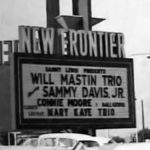
Breaking down barriers at The Last Frontier
When the Trio were signed to appear at the Last Frontier in Las Vegas in January 1954, it was with special contract conditions. While Lena Horne had been allowed to stay at the Flamingo when she was performing there as early as 1947, she had been made to steer clear of the amenitites – casino, restaurants, pool, bar, anywhere public. Legend has it that when she checked out, a maid would collect her sheets and towels and burn them. But according to this new contract, Davis and his entourage would stay in the Frontier’s best suites and had free run of all facilities. This was likely the first such deal, and a landmark achievement in breaking the colour barrier in Las Vegas. Davis would later play a pivotal role in convincing Jack Entratter to fully desegregate the Sands Hotel in 1960.
Sammy broke other barriers in the 1950s: In 1953, ABC shot a TV pilot for a 30-minute sitcom featuring Sammy, Sam and Will as a family of entertainers, but the pilot found no sponsors willing to back a show with a black lead. Nevertheless, this was a significant milestone for an African American entertainer. In 1956, Sammy’s Broadway show Mr Wonderful utilised a half-black half-white company, noteworthy for the time. In 1958, he shot a starring role in an episode of the television anthology series General Electric Theater, making him only the second man to star in a TV drama, after Sidney Poitier in 1955. GE shelved the episode, fearing a backlash in the South, but eventually screened it in October.
Inter-racial romance and the Kennedys
One aspect of Sammy’s life caused continual controversy: he was an inveterate playboy and frequently seen in the company of white women at a time when miscegenation was still illegal in more than 20 States. A relationship with Kim Novak in 1957 had led to death threats from the mob and a hastily arranged marriage to an African American dancer, Loray White, which lasted 8 months. But he met the true love of his life – May Britt, a Swedish actress – at the start of 1960. The announcement of their engagement in London in June 1960 made headlines in the US, with condemnation from white racists and muted criticism from the black community. In England, the British Fascist Party staged a rally outside the Club Pigalle where Davis was performing, carrying banners which read “Go home, nigger” and “Sammy back to the trees”.
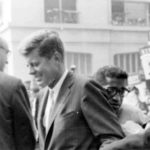
Kennedy and Sammy
There were significant political consequences from the emergence of Sammy and May’s relationship. Frank Sinatra, who had agreed to be Sammy’s Best Man, was very supportive of John F. Kennedy and was heavily involved with the Kennedy Presidential campaign. Accordingly, Sammy worked hard for Kennedy on the campaign trail. The Kennedy people would give him a list of rallies and cocktail parties in cities and towns where he was playing, and he would voluntarily attend these gatherings, sometimes to sing a song or just mingle with the guests. Increasingly, though, voices inside the Kennedy campaign saw him as a potential liability.
When he was introduced onto the stage in July 1960 at the Democratic National Convention alongside Sinatra, Peter Lawford, Nat ‘King’ Cole and other friends to sing the National Anthem, he was loudly booed by the Southern delegates. When Sammy opened soon after at the Lotus Club in Washington D.C., there were more protesters outside the club – the placards reading “Go back to the Congo you kosher coon”, and “Can’t you find a coloured girl?” Soon, Kennedy was being hit by some critics as approving interracial marriage. Sinatra was being singled out as well, especially when newspaper stories about Sinatra being Davis’s Best Man sometimes suspiciously ran next to stories about Sinatra campaigning for Kennedy.
Feeling the pressure, Davis decided to put off the wedding, scheduled for October, until after the general election on 8 November. It was a terrible dilemma. As Sammy later wrote in Why Me , “What could I say to May? ‘We’re postponing our marriage because it’s so repulsive to some people that they won’t want to vote for Kennedy’.”
The wedding went ahead five days after the election. Sammy’s reward for his loyalty to the Kennedys was to be disinvited from the President’s inaugural celebration gala the following January – a star-studded spectacle co-ordinated by Sinatra. Sammy’s marriage made him a lightning rod for controversy at that moment. Occasionally portrayed by modern critics as reflective of Kennedy’s own supposed racism (an explanation which makes little sense given that Harry Belafonte, whose wife, Julie Robinson, was white, attended and performed), the decision was more likely an example of Kennedy’s capacity for realpolitik, given the political power of southern Dixiecrats of the era. Sammy found out about his exclusion three days before the event. His absence was conspicuous, and he was devastated by Kennedy’s betrayal.
Sammy didn’t hold a grudge, however. He later wrote: “I did understand, that hatred got noticed and had to be neutralized, whereas love could be put on hold. I understood that in politics a thousand votes were exactly one thousand times more valuable than one friend.” In the summer of 1962, Sammy was invited to perform in Washington D.C. for President Kennedy and the two met face-to-face after the show. Sammy later said “What a thrill it was, because I don’t care what your political affiliations might be – whether you be a Republican or Democrat – to meet the President of The United States is something. I’m telling you, it’s too much.”
Civil rights activities
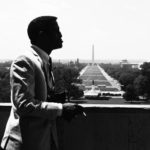
March on Washington 1963
Sammy became a regular supporter of civil rights causes, starting with concerts in 1961 in support of Martin Luther King’s Southern Christian Leadership Conference, at Carnegie Hall in January with Sinatra and Dean Martin, and in Los Angeles in June. Throughout the mid-1960s, Sammy would become one of the civil rights movement’s greatest financial instruments, performing at an endless number of benefits, and generating a huge amount of money. In August 1963, Sammy joined King in Birmingham, Alabama, for a concert to raise funds for the upcoming March on Washington. Despite some trepidation on his behalf due to the number of threats made to disrupt the March, Sammy was present in Washington D.C., and sat two rows directly beneath King on the Lincoln Memorial as King delivered his “I Have a Dream” speech.
At this time, Sammy’s name was on the White Citizens Council’s ‘Ten Most Wanted’ list – and Davis would continue to remain a controversial figure following his return to Broadway in Golden Boy in 1964. The musical dealt with the struggles of a boxer involved in a romance with a white woman (Paula Wayne) – a plot which led to protests and regular bomb threats. Wayne said in 1990: “I never expected such hatred. I never expected such vitriolic things would be said to me. But Sammy did. He told me the only way to deal with hatred is not to dignify it. And he always stood by me. There were lots of race riots going on – in Detroit, Chicago, everywhere. The march on Selma took place while we were playing on Broadway. But I was still not expecting the kind of problems we had.”
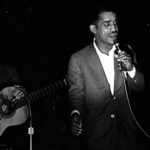
Stars for Freedom Rally 1965
Sammy was present at the civil rights march from Selma to Montgomery during the run of Golden Boy. In the immediate wake of Bloody Sunday, Sammy had been fearful for his life, and had to be convinced by Harry Belafonte to join. However, he made it to the campsite at the city of St. Jude on the outskirts of Montgomery and there, on the night of 24 March 1965, on a makeshift stage of coffins, a ‘Stars for Freedom’ rally was held for the several thousand marchers.
Sammy sang the National Anthem, and he, Belafonte, Tony Bennett, Nina Simone and others all performed. Thousands more people continued to join the march. The next day 25,000 people, Sammy among them, marched to the steps of the State Capitol Building in Montgomery where Martin Luther King delivered the speech “How Long, Not Long”.
In June 1966, Sammy attended a rally in Mississippi to promote black voter registration, despite being told by Bobby Kennedy that he was a target. Davis said “I’m not going down there to get shot, but we can’t all sit around Beverly Hills talking about it. Somebody has to do something.” Davis performed, and introduced King. When King was shot in 1968, Davis immediately went on television across three networks calling for calm, as race riots broke out across the country.
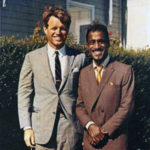
RFK and Sammy
King’s death came at a time when Davis was struggling to come to terms with notions of black power, the changing nature of black identity and the more militant approach to the battle for civil rights being favoured in cities like Chicago. Through 1968, Davis decided to throw his weight and energy into campaigning for Bobby Kennedy, with whom he was far more friendly than he had ever been with JFK. While in Chicago preparing for the London revival of Golden Boy, Sammy would campaign for Bobby on his days off at small colleges in the nearby states of Nebraska and Indiana. Davis was in London when Bobby too was assassinated.
In 1968, Sammy was awarded The Spingarn Medal, which is awarded annually by the National Association for the Advancement of Colored People (NAACP) for outstanding achievements by an African American. Sammy’s feature role in the civil rights struggles of the 1960s has been sadly overshadowed by his later regrettable association with Richard Nixon. Harry Belafonte has said: “Sammy did a lot of things for Dr. King and for our movement. His commitment was never really fully recognised historically. He stepped up to the table and not only gave money, but got a lot of his friends involved.”
Involvement with President Richard Nixon
Starting in 1969, Sammy had regularly socialised with Robert J. Brown, a management consultant who had been close friends with Martin Luther King, and was on the board of the Southern Christian Leadership Conference. Brown was now working as a special assistant to President Nixon, and was responsible for recommendations on urban policy. In conversations, Brown felt Sammy was earnest and knowledgeable, and recommended he be appointed to a seat on the National Advisory Council on Economic Opportunity. The announcement was made in July 1971, with Nixon introducing Davis to the cabinet members and speaking to him at length in the Oval Office. Sammy took his work on the Council seriously, and kept in regular touch with Brown and Nixon. Several months later, after Davis challenged them on the drug issue confronting African American soldiers in Vietnam, Nixon requested that Sammy visit Vietnam and report back his findings.
Sammy undertook this trip in February 1972, flying into Saigon in a C-50. He spent 10 days there, touring the rehabilitation centres, interviewing rank and file soldiers about their experiences and performing 18 shows for as few as 50 people and as many as 12,000. He would find it one of the most rewarding experiences of his career. Upon returning to the US, Davis submitted 20 recommendations to Nixon, and 10 were swiftly enacted, including the most important from Davis’s point of view – transforming the rehabilitation centres from pseudo-prison camps back into hospitals.
Meanwhile, despite growing criticism from some regarding his involvement with Nixon, Davis gradually became more involved in Nixon’s campaign – he donated $10,000 to a National Black Committee Dinner for the Republican Party, and was proud that Nixon agreed to attend, his first all-black event. He endorsed Nixon for the 1972 election, and agreed to MC and perform at the Republican Youth Rally at the Republican National Convention in August. That same week, Davis’s music producer, Mike Curb, learned that “The Candy Man” single had gone Gold, and discussed with Nixon’s campaign whether Nixon might surprise Davis at the rally by presenting Sammy with the Gold record.
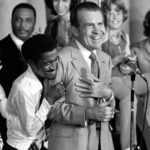
Hugging Richard Nixon
Sammy was duly presented with his Gold record at the rally. Nixon didn’t make the presentation himself, but he did come on stage immediately afterward and, aware of the public criticism Davis had received, defended Sammy: “You can’t buy Sammy Davis, Jr. by inviting him to the White House. You can only buy Sammy by doing good things for America”. Sammy hugged him. The resultant photo set off a firestorm of controversy and a new wave of hostility – from blacks critical of Sammy’s figurative embrace of Nixon, to white racists critical of Nixon’s literal embrace of Sammy, and Davis’s white liberal friends critical of his seeming conversion from Democrat to Republican. Unfortunately, Sammy’s credibility on civil rights was dealt a crushing blow by the long-lasting image of the two together on stage.
In retrospect, some argue that Davis and Nixon quickly developed a genuine rapport, that Sammy had the ear of the President and was sincerely trying to effect policy changes that would benefit the black community – with some conspicuous successes. Others argue Nixon took advantage of Sammy’s legendary susceptibility to flattery by offering meaningless sinecures in exchange for Davis promoting the otherwise false impression that Nixon actually cared about the plight of the black community. No doubt there is some truth to both characterisations – but either way, the experience left Sammy ostracised and shunned by all sides of the political spectrum.
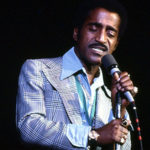
Booed on stage at PUSH 1972
Soon after, he was booed at a concert on behalf of Jesse Jackson’s Operation PUSH in Chicago. It hurt – Davis would later tell Ebony magazine “The worst moment in my life was being booed by my people in Chicago. I cannot begin to tell you what that did to me. Nothing has ever hurt me that much. My accident, when I lost my eye, didn’t hurt that much.” James Brown was also working for Nixon at the time, and told Sammy “Whew, you’re taking a lot of heat. I never got it this way.”
In May 1973, Nixon invited Sammy to entertain in the White House at a concert, hosted by Bob Hope, to celebrate returned Prisoners of War. In addition, Davis and his wife Altovise, whom he had married in 1970, stayed overnight in the White House residence, thereby becoming the first African American guests to do so. As Nixon’s Watergate scandal metastasised, Davis found his policy recommendations going nowhere with an increasingly embattled President. By October 1973, Davis publicly renounced his support for Nixon, and would largely regret his involvement with him. While Sammy continued to support worthy social causes financially and through performing at benefits for the rest of his life, he remained largely silent on political issues – even when Sinatra publicly supported Ronald Reagan in the 1980s.
What Sammy told Alex Hayley in 1966 was true for most of his life: “It’s a pain in the ass sometimes to be Sammy Davis, Jr., because I just can’t make a right move race-wise. I’m proud to be black, but I don’t want my blackness to be a burden to me.”

